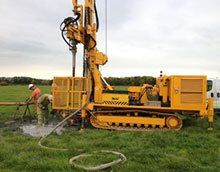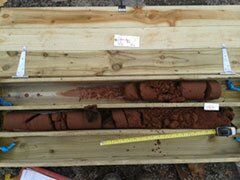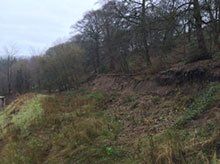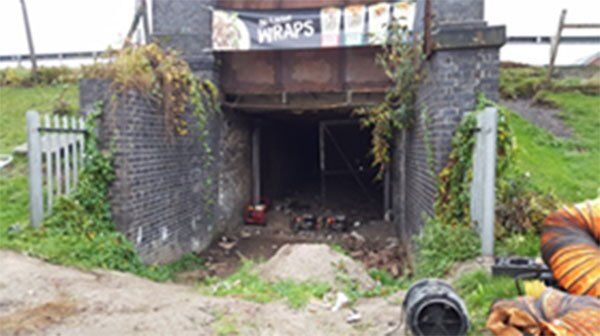Earth Environmental – January 2016 News
 We have recently welcomed two new staff members Mathew Holker and Peter Lynch to our Stockport office.
We have recently welcomed two new staff members Mathew Holker and Peter Lynch to our Stockport office.
Mathew is a very experienced Civil Engineer who started his career with BNFL and has a strong background in the investigation, assessment and remediation of asbestos contaminated sites. He has previously worked for a number of large consultancy practices and Stockport Borough Council.
He is currently involved in the development of a remedial strategy and overseeing the remediation of a former landfill site, for a new residential development in Bollington.
In his spare time he is an active member of the Manchester Amateur Operatic Society.
Peter Lynch is a geologist who studied at Manchester and Lancaster Universities and has several years of experience of working as a monitoring technician and geoenvironmental consultant at several practices.
NEW SERVICE
The Plate Bearing Test (or Plate Loading Test) is an in-situ field test used to determine the ultimate bearing capacity of rocks and soils and anticipated settlement beneath an imposed load.
It is routinely used in the design of temporary structures such as working platforms for piling rigs or pads for crane outriggers. Approximate equivalent CBR values can be derived from the Modulus of sub grade reaction by use of empirical relationships.
The Plate Bearing Test is carried out in accordance with BS 1377 Part 9: 1990 and consists of loading a steel plate and recording the settlement corresponding to each load increment.
The Plate Bearing Test is normally carried out at foundation level, either on the surface or in a shallow pit. Plates of varying sizes up to 720mm diameter are available. The loading plate is placed on the ground and connected via a load cell to a reaction load. Due to the larger size of the plate used (compared with a CBR test) this test is more suitable for testing larger aggregate backfills, however, it requires a larger reaction load. Typically, a minimum 15tonne tracked excavator or other suitable plant is required for us to use as a reaction load.
Our engineers will advise on the plate size required to match the design load and reaction load required (i.e. size of excavator).
We can typically complete six tests in a day, subject to site conditions and can provide results the following day.
PROJECT NEWS
Solar Farm, Nottinghamshire
 We were commissioned to undertake a GeoEnvironmental & Coal Mining Site Investigation of the site for planning and design purposes, following the development of a coal mining risk assessment.
We were commissioned to undertake a GeoEnvironmental & Coal Mining Site Investigation of the site for planning and design purposes, following the development of a coal mining risk assessment.
The objectives of the investigation were as follows:
- Surveying of site during site investigation and setting out of mineshafts
- Assessment of shallow coal mining regime
- Assessment of ground gas regime and delivery of ground gas risk assessment
- Assess ground conditions for foundation design purposes.
The site investigation disproved the presence of shallow workings beneath the invertors and DNO cabins and provided recommendations for the solar farm panel foundations. Helical piles were recommended due to the presence of colliery fill.
Travis Brow, New Relief Road, Stockport
 Stockport MBC is undertaking a feasibility study for a new link road between the M60 and the A6 in Stockport. It was intended for the proposed new road to cut into sloping ground below one of the arches of the Stockport Viaduct. A disused railway tunnel was present in this location which would have to be removed.
Stockport MBC is undertaking a feasibility study for a new link road between the M60 and the A6 in Stockport. It was intended for the proposed new road to cut into sloping ground below one of the arches of the Stockport Viaduct. A disused railway tunnel was present in this location which would have to be removed.
As part of the study, a ground investigation was undertaken to pinpoint the exact location of the railway tunnel and to assess the depth and nature of the existing foundations to the Stockport Viaduct.
The investigation also obtained soil and rock geotechnical parameters for the design of retaining walls to support the road through cut slopes. Geoenvironmental information was also included for a human health risk assessment.
The railway tunnel was located with trial pits and trenches excavated at locations selected using historical maps. The tunnel was around 1m deep and constructed of brick with a bitumen seal.
The foundations to the existing railway viaduct were investigated via rotary coring at an angle of 20˚, with the drilling rig set up under the arches of the bridge.
The sandstone bedrock was photographed, described in accordance with BS5930 2015, sampled and tested in the laboratory to provide a complete picture of the ground conditions and potential risks to the scheme.
An interpretative report was produced detailing:
- Desk Study
- Foundation Design Parameters
- Human Health Risk Assessment
Slope Stability Project
 We are currently investigating a landslip at the rear of a residential development site in Yorkshire. A small distressed retaining wall was removed to facilitate the construction of new residential apartments. Unfortunately the activity resulted in mass movement of superficial deposits overlying a shallow bedrock surface.
We are currently investigating a landslip at the rear of a residential development site in Yorkshire. A small distressed retaining wall was removed to facilitate the construction of new residential apartments. Unfortunately the activity resulted in mass movement of superficial deposits overlying a shallow bedrock surface.
Examination of aerial photographs showed that the landslip was present in 2006 and that previous consultants had failed to identify the geomorphological feature as a slip scar.
Our current work involves the installation of slip indicators in the slope as well as slope stability modelling of potential remedial measures.
Minton Hollins, Stoke-on-Trent
A GeoEnvironmental Site Investigation was commissioned to examine ground conditions and retrieve soil samples for chemical and geotechnical testing at a derelict and vacant site off North Street in Stoke-on-Trent.
A planning application submission is being prepared for a new four storey 1600 unit student apartment complex with managed landscaped areas.
At the time of the investigation, the site area consisted of a vacant and derelict site, largely covered by concrete, with a culverted watercourse on the north eastern boundary and the former Minton Hollins tile works factory building (a listed building) used as business office units.
The site was formerly the Minton Hollins tile works that was established in 1899. The tile works was initiated by Herbert Minton who developed the encaustic process, using pigments mixed with hot wax which were buried in an inlay.
During the site investigation numerous relict features were exposed and carefully logged by a team of archaeologists.
Former Gas Works, Blackpool

Blackpool Council proposes to infill a former gasworks subway, which supports Seasiders Way, with self-levelling concrete. It is understood that the subway needs infilling to support the overlying roadway.
A site investigation was required to assess the ground conditions, ground suitability and provide comment on the suitability of proposed plans and any settlement issues.
The site investigation has proved a sequence of made ground underlain by peat, soft clays and in turn firm to stiff clay.
A vertical core revealed that the subway has been constructed on a concrete footing of approximately 0.90m thickness, onto stiff clay at 2.30m bgl.
The thickness of the existing subway walls ranged between 2.07m and 2.18m, and comprises of red brick and consolidated concrete.
Several unexpected services were located during the investigation, including three 600mm cast iron pipes.
Potential contaminants of concern in soils were found to be less than assessment criteria for a commercial end use.
Remediation Project, Bollington
We were requested by a client to provide a Remediation Strategy involving a new residential development on an old landfill site that has been found to contain asbestos fragments and fibres. A previous remediation strategy by other consultants was considered to be too outdated and therefore a revised strategy was submitted to the local authority.
This involved the re-use of site won materials and a reduced thickness of cover materials within front and rear garden areas.
Due to the presence of asbestos in soils extensive monitoring of dust and asbestos dust has been implemented prior to and during construction activities.



